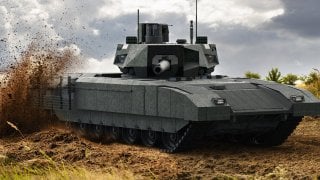Russia's T-14 Armata Tank Nightmare Just Won't End
Summary and Key Points: The war in Ukraine has underscored the continued relevance of main battle tanks in modern warfare, despite previous predictions of their obsolescence.
-The Russian military's heavy losses have led it to deploy outdated tanks from the 1950s and 1960s.
-Meanwhile, Russia's supposedly advanced T-14 Armata tank has been plagued by development issues and has seen limited deployment in Ukraine, likely due to fears of exposing its vulnerabilities.
-The T-14's future is uncertain, with the possibility that ongoing problems and high costs may lead to its abandonment or a complete redesign.
Russia's T-14 Armata: A High-Tech Tank with a Troubled Future
If the war in Ukraine has taught one lesson above all other, it is that main battle tanks are still very important in modern warfare.
Before Russia invaded in 2022, plenty of observers thought tanks would be irrelevant in a conflict between two states. Indeed, former British Prime Minister Boris Johnson, a stalwart supporter of Ukraine, opined as recently as November 2021 about the end of the tank era.
But tanks keep on rolling. Battlefield demand for the steel behemoths is so high that the Russian military is pushing into service ancient vehicles from the 1950s and 1960s to replace its more than 3,000 tanks destroyed thus far. To an outsider, this decision is that much odder given that Moscow has in its arsenal one of the most advanced tanks in the world: the T-14 Armata.
Or does it?
The T-14 Armata and Its Ongoing Problems
The T-14 Armata is a main battle tank weighing approximately 55 tons and equipped with a 125 mm main cannon. It requires a crew of three men (commander, driver, and gunner) and uses an automatic loading system for the main gun, much like other Soviet- and Russian-made tanks.
In development for over a decade, the T-14 Armata has been plagued by mechanical and technological issues. To date, the Russian military has only received a handful of T-14 tanks.
The Kremlin has claimed at specific points in the conflict that its forces deployed the T-14 Armata in Ukraine. TASS ran a story about how the new Russian main battle tank was performing in Ukraine, highlighting that it was deployed for the sake of experimentation, to ensure the T-14’s features fit modern operational realities.
“The Armata tank was used several times in the combat zone in Ukraine. Based on the results of the use in the special operation, the vehicle is now being finalized,” Russian defense officials told TASS.

But Ukrainian officials and Western intelligence estimates dispute Russian claims about the T-14’s combat experience. Instead of seeing combat against the Ukrainian military’s Western weapons systems, a handful of T-14 Armatas were restricted to areas close to the battlefield. This is in line with how the Kremlin is seen treating other modern weapons like the S-500 Prometheus air defense system and Su-57 Felon fighter jet. Moscow has held these systems back, most likely fearing humiliation.
With the Russian military mired in Ukraine and no hopes of a quick victory, it is becoming increasingly likely that the T-14 Armata won’t see the end of this decade unless something radically changes. The mounting costs of the Armata and its continuing mechanical and technological issues will likely force the Russian military to ditch the project or order a complete redesign that better matches the capabilities of the Russian defense industry.
About the Author
Stavros Atlamazoglou is a seasoned defense journalist specializing in special operations and a Hellenic Army veteran (national service with the 575th Marine Battalion and Army HQ). He holds a BA from the Johns Hopkins University and an MA from the Johns Hopkins’ School of Advanced International Studies (SAIS). His work has been featured in Business Insider, Sandboxx, and SOFREP.
Image Credit: Creative Commons and/or Shutterstock.


